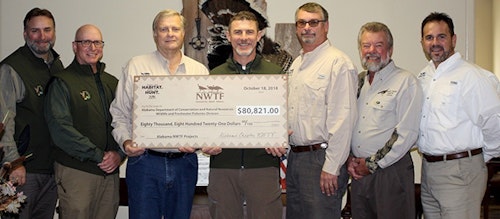
Find a possible mentor that can help you grow your business and offer advice. (Photo courtesy of ATA.)
The archery and bowhunting industry is booming after people sought outdoor recreational activities during the COVID-19 pandemic, but there’s always room for improvement.
Your Archery Trade Association spoke with two ATA partners and two ATA board of directors members to learn how ATA members of all sizes, strengths and abilities can work to grow and strengthen the industry. Here’s what they had to say.
Improve Your Business, Position Yourself to Better Accommodate Customers
Drew Arnesen, director of sales for Kinsey’s and a representative for the ATA board of directors, says business education is important for everybody in the industry.
“The industry is a collection of parts, and everything has to be functioning properly so we can help people,” Arnesen said. “Strength in one area can help cover the weakness of another area, but every business owner needs to make sure their business is protected, safe and healthy. That promotes growth and keeps the industry insulated from retraction.”
Analyze your business to determine its strengths and weaknesses. Then resolve to make improvements. Arnesen offers the following tips.
• Check your finances: Many industry members enter the business world to pursue their passion, but passion won’t ensure a productive business. Know your numbers. Watch your overhead and profit margins. Get a system that tracks everything, and work with an accountant or financial advisor to ensure you’re on track.
• Make smart hiring decisions: Get the right people to represent your brand. This is often an afterthought for businesses, but it’s important to get talent who can help grow your business.
• Market your brand, products and services: Figure out the best way to engage with current and potential customers through different mediums and platforms. Do community outreach to connect with different generations and types of people.
• Find a business mentor: Mentorship takes place from an archery and bowhunting perspective, but business owners need good mentors and role models, too. Find someone who is open to taking questions and offering advice to teach you the skills you need to flourish.
Go a step further and take a business education course (or two or three). When your business is in order, you have more time to focus on customer service and support. Kinsey’s hosts an annual management training seminar for retailers called the Global Leadership Summit. The ATA has business-related courses in the MyATA learning center, too. Log into your MyATA member dashboard (www.archerytrade.org/login) and click “MyATA Learning Center” to get started.
Educate Yourself, Your Staff and Consumers About Their Role in Conservation
Chuck Sykes is the director of the Wildlife and Freshwater Fisheries Division of the Alabama Department of Conservation and Natural Resources and chair of the Association of Fish & Wildlife Agencies’ Hunting and Shooting Sports Participation Committee. He says that many consumers and industry members don’t understand what state wildlife agencies do and how they’re funded — and that hinders industry growth and support.
In short, manufacturers pay a 10% or 11% federal excise tax (FET) on firearms, ammunition and some archery gear. The tax originated in the 1937 Federal Aid in Wildlife Restoration Act, more commonly called the Pittman-Robertson Act. Congress added archery equipment to the FET in 1972. The IRS collects all revenues generated by the FET and sends them to the U.S. Fish and Wildlife Service for distribution to state agencies. States must use that money for habitat restoration, hunter education, wildlife research, recruitment efforts, public-access programs and other high-priority conservation projects.
This “user-pays, everyone-benefits” cycle of success secures customers for ATA members and the future of archery and bowhunting, but Sykes says that the general lack of understanding could negatively affect decisions at the polls.
“Teaching people what we do, why we do it and how we afford to do it is important,” Sykes said. “Many people don’t know where their money goes. They think their general tax dollars pay for our services, and that can be a huge problem at the ballot box. We need everyone to be educated about what we do and how we’re funded in case there are ballot referendums that come up in opposition to hunting, fishing, and good, sound wildlife management.”
Everyone needs to understand that hunting is a productive tool in conservation, and they need to let that knowledge inform their voice and vote. That’s why the Alabama DCNR partnered with the ATA and other industry representatives and invited Alabama ATA members and others to a piece of public land obtained using FET funds. WFF representatives showed them around, explained department responsibilities, educated them on the P-R Act and how FET funds work, and encouraged them to spread the word. Sykes encourages ATA members and state wildlife agencies to work together to reach more people.
Contact your state agency for marketing materials and to learn about partnership opportunities that help educate the public about archery and bowhunting’s role in conservation. Use the ATA’s state contact webpage at www.archerytrade.org/contact-us/state-contacts to find out how to reach your state representatives. The ATA also has resources in the ATA’s Resource Website to help ATA members explain the process to existing and potential customers. Log into your MyATA member dashboard and click “Download Free ATA Resources” to find the materials.
Partner With Other Entities to Host Events
Jay Scholes, ATA board member and Outtech chairman and founder, believes ATA members need to spend more time creating enjoyable archery and bowhunting events for beginners and longtime archers. Better yet, he says, ATA members need to work together to amplify their efforts.
“There are a lot of brilliant and talented people in our industry, and they’re all willing to help,” Scholes said. “It’s easy to get people to say ‘yes.’ You just have to make the ask.”
Scholes recommends partnering with retailers, manufacturers, state agencies, media members, conservation groups, local businesses and community members to host regular events. ATA members must be creative and give people a reason to engage with archery, especially because they have other activities and obligations that compete for their time and attention.
There are lots of ways to do this: Invite an outfitter to talk about hunting strategies or opportunities. Ask sales reps to demo their products. Work with conservation organizations to talk about habitat management or give a game calling lesson. Ask manufacturers to provide how-to seminars. Connect with your state agency to host a wild game dinner. And work with vendors and community members to put on a mini bowhunting show or small-business festival. “Get creative,” Scholes said.
These events attract customers and encourage them to buy archery gear and equipment, which benefits all ATA members and state agencies. They also increase traffic and exposure for your brand — and the industry.
Use the ATA’s Archery Event Planning Workbook and Archery and Bowhunting Event Ideas document to plan and execute fun, engaging and profitable events year-round. The former helps members plan events, and the latter gives members event ideas to consider. The resources are available in the ATA’s Resource Website.

Grow Participation Through Mentoring and R3 Efforts
Nick Pinizzotto, National Deer Association president and CEO, and ATA partner, encourages people to mentor newcomers and constantly work to recruit, retain and reactivate sportsmen and women.
“Every segment of the industry — from the retailer all the way back to the distributor and manufacturer — has a role to play in recruiting,” Pinizzotto said. “Increasing participation numbers is everything to the industry. It’s really about fueling that machine.”
Pinizzotto says ATA members must approach growing participation numbers thoughtfully. He suggests targeting adults and nontraditional audiences. Why? Adults have the means to buy equipment and can make decisions on their own, unlike most youths, who rely on guardians for money and transportation. Likewise, those who didn’t grow up in archery or bowhunting families have likely never had the opportunity to experience archery.
For example, the NDA introduces people to hunting by allowing them to try wild game meat at farmers markets. They invite interested individuals to learn about bowhunting through a Field to Fork event, which teaches newcomers how to hunt for meat and then cook it. Taking a small-scale approach and mentoring beginners individually also helps with retention.
These participants become customers, and so the industry ends up with more licensed hunters who will pass on the activity to others in their circles. “It’s a snowball effect that strengthens the entire industry,” Pinizzotto said. “You’ll be surprised how just a little effort can go a long way. If you help one person become a hunter, you can easily turn that one person into six, eight or 10 people, and it goes from there.”
Use the ATA’s Hunting Mentor Guide and Field to Fork curriculum book for guidance as you recruit newcomers. Both documents are available to ATA members to download for free in the ATA store (www.archerytrade.org/store). You can also connect with NDA’s Hank Forester (www.deerassociation.com/about/staff) for advice or to discuss partnership opportunities.
Let the ATA Help
Visit the ATA’s membership page at www.archerytrade.org/membership to learn about your ATA member benefits and the many resources offered to you for free.
Let Wendy Lang, ATA’s senior membership manager, know if we’re missing a resource. Contact her at wendylang@archerytrade.org. She’ll work with the Member Benefits Advisory Team to explore the options.
If you have questions or need help, contact the ATA business, membership and Trade Show office at (866) 266-2776, option 1.






